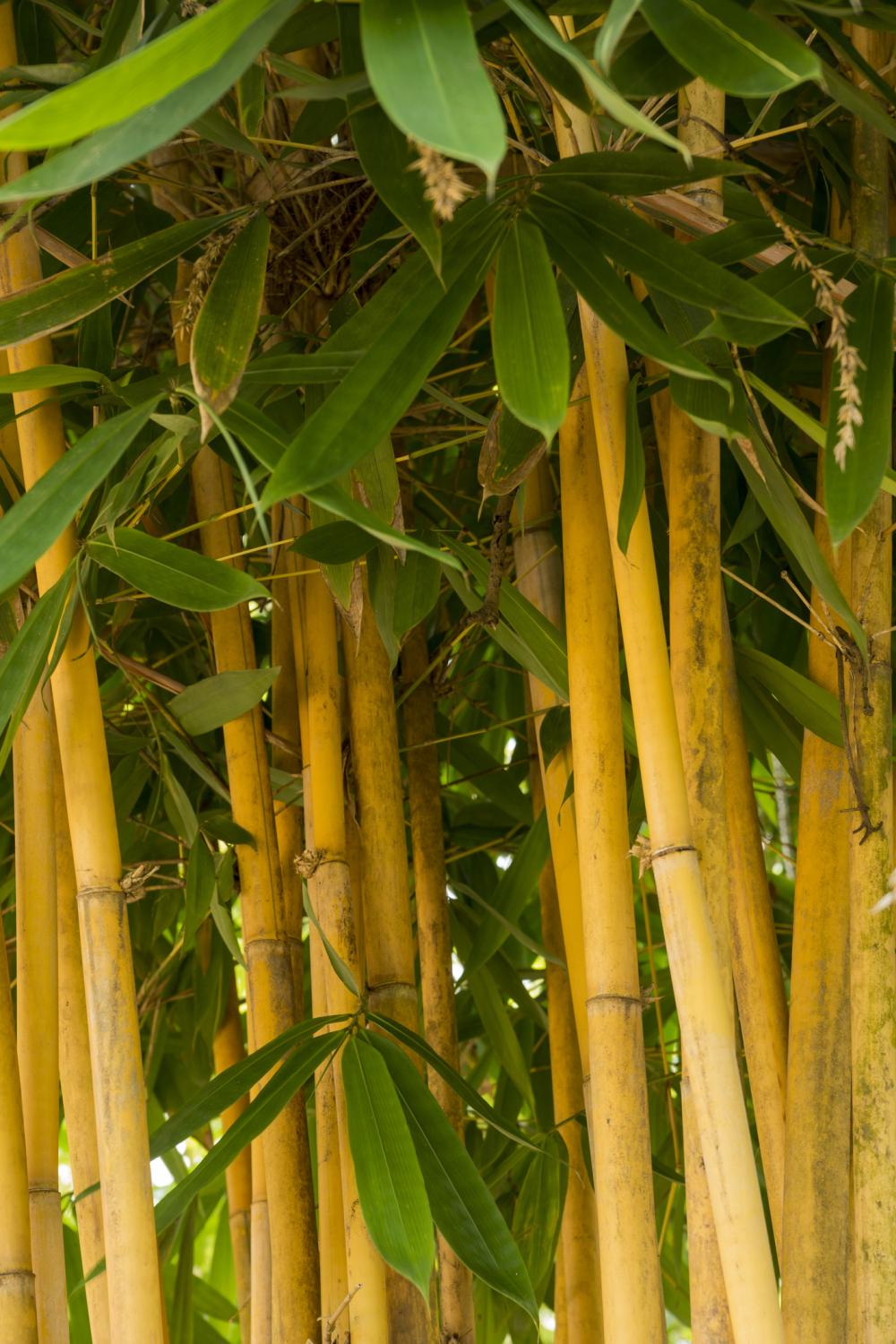How to Grow the Golden Bamboo
Bamboo plants are a perfect housewarming gift. If you’re looking to grow a garden plant for privacy reasons or bordering, the Golden Bamboo outdoes itself when it comes to these two priorities.
It can achieve higher heights, compared to other garden plants, and is deer resistant, so there won’t be a need for moving the plant indoors during colder months. Let’s check out some of the practical ways to grow and care for the golden bamboo.
More About the Golden Bamboo
Looking at its habitual traits, the golden bamboo grows and matures like herbaceous perennial plants. Its scientific name is Phyllostachys aurea. You might find other gardening stores labeling it the fish-pole bamboo. What makes this type ideal for fencing and privacy screening is its potential to reach beyond 20 feet in height. If you’re looking for an inexpensive noise barrier, growing this outdoor charmer is all you need.Besides its flamboyant ornamental value, the golden bamboo is notably a fast grower. In two years or slightly more, the plant can reach a mature height and spread its roots wide for a firmer base.
It’s quite easy to grow the golden bamboo using rhizomes during the spring or fall season. Under the hood, the woody stems are hollow and are lance-shaped. On the lower side of the cane, the golden bamboo is characterized by a yellow-green pattern that resembles a tortoiseshell. You’ll also spot some compact internodes connecting the stems. Same as most other bamboo species, this type hardly blooms even when growing outdoors. It’s also rare to see the golden bamboo producing any seeds. If you’re lucky, it might bloom after a decade.
How to Grow the Golden Bamboo
You can reproduce the golden bamboo through running. It’s a phrase that simply means letting the roots spread further. Whether you’re growing it as a windbreaker or bordering, the best time to begin the exercise is during spring when new growth is about to emerge. These pointers will help you grow a peachy golden bamboo in your garden:
- Designate some space in your lawn and clear it, then add some loose and well-draining soil. Make sure to look out for a spot that receives enough bright, filtered light.
- If you can’t find such a position, the other option would be to grow your golden bamboo inside a container. This way, it’s easy to find a spot that has some partial shade, but you’ll need to replace the old soil after a while.
- To give a running bamboo ample space for spreading its rhizomes, dig a planting hole that’s between 20’ to 40’ inches deep. Each hole needs to be twice the size of the root ball.
- Use a high-density plastic bag to create a barrier on the edges of the planting hole. This helps prevent the rhizomes from spreading aggressively.
- Place the rhizomes in the middle of the planting hole, then fill it with loose, organic-rich soil. For the next 4 months or so, keep the soil evenly moist every day to promote the growth of roots.
- Once the roots are established, cut back the watering intervals to once each month even during the warmer months. While you’re at it, cross-check to see if the soil is draining excess moisture effectively.
- For lush and healthy foliage, use a balanced and soluble fertilizer once a month during the growing seasons, preferably in the ratio of 10-10-10. You can start using the fertilizer in the spring right before new growth begins to show up.
- Over time, some unwanted growth might begin to emerge. Get rid of shoots developing on the edges of the parent plant to eliminate any potential competition of the essential nutrients.
Golden Bamboo Caring Tips
Light
Your Golden Bamboo will look more elegant if it’s receiving enough light. It will also need some partial shade to cool it off and block any intense heat from burning the leaves. While this herbaceous perennial is known for growing tall, the rate at which it elongates all depends on the amount of light it gets. The goal is to grow your golden bamboo in a position that gives it access to between 6 and 8 hours of bright, filtered light each day.
Over time, as your bamboo gets older, you will soon realize that the foliage will turn from its dense green tone to yellow. For the most part, the dramatic change in color will be contingent on the amount of light receives. It’s worth noting that newly grown bamboo seedlings need the most protection from the sun, especially during hot days. Growers living in hot climates tend to plant their bamboos in a damp location that will cool them off. This variety thrives a lot better when growing under USDA hardiness zones 7 to 11. If you’re planting your bamboo for privacy, the most essential thing to do is give it some partial shade as it receives bright light.
Soil Requirements
The golden bamboo spreads using underground tendrils known as rhizomes. For this reason, you will need to use a soil structure that has been loosened up a bit to give room for more growth. There isn’t any suitable formula to work with when preparing the potting soil. All you should aim at is using soil that retains some moisture, drains any excess water in due time, and holds all the essential nutrients organically. If you’re looking to use this variety for privacy, it might not achieve the optimal height if the soil you’re using is poor and lacks useful nutrients. The seedlings will get clamped together and fail to elongate further. There won’t be a need for transplanting your golden bamboo since it will be growing outdoors and most likely, you’ll be using it to fence your backyard.
Potting & Repotting
If you’re growing your golden bamboo for noise buffering or as a privacy screen, then you don’t need to worry about which container to use. However, growers using the plant for its ornamental value should consider using a sizeable growing pot that makes the plant rootbound, thus controlling the overall height and preventing the rhizomes from spreading further. The goal is to prevent the plant from aggressively invading any idle space. Ideally, you want to work with a container that’s at least 10’ inches wide. Its depth should also be in the same range. While it’s best to work with loose soil that retains some moisture, choose a container with enough drainage holes that will help let out any excess water.
Watering
Throughout the growing seasons, your golden bamboo will need a moist environment quite consistently. One primary reason why mulching is of utter importance when planting the seedlings is that the plant prefers to grow in soil that has the capacity to retain some moisture. And if it’s growing inside a container, your bamboo might need to be watered a few times every week, especially if the temperatures are warmer. Once the plant is fully established, it can tolerate drought-like conditions fairly well. While constant irrigation seems to be the rule of the game, make sure not to leave the soil waterlogged since the rhizomes could be exposed to rotting. For this reason, you’ll need to use a soil structure that supports drainage.
Spacing
As it matures, one division of your golden bamboo will begin to screen. If you’re looking to build a privacy screen fence within a short span of time, you will need to grow your bamboo seedlings 3 to 5 feet apart.
Temperature & Humidity
Golden bamboos aren’t fussy about temperature conditions. They can grow in a number of temperatures, so long as you can mimic the tropical environment where they’re native. What’s striking about this species is its cold-hardy traits. It can tolerate temperatures falling below 15 degrees Fahrenheit, but the overall growth rate will be slashed significantly mostly if it’s a long cold season. If possible, try to mimic the tropical environment where it’s accustomed to. Therefore, you want to give it a relatively higher humidity level compared to other outdoor plants growing in your garden. Even if it prefers warm and moist conditions, it can still survive when there’s a long cold period.
Feeding
When growing outdoors in the ground, golden bamboos don’t necessarily require to be fed. All you need to focus on is space the seedlings out when planting them so they don’t compete for nutrients, and use organic-rich soil. For bamboos growing inside containers, the organic matter might get depleted over time. So, you want to use a balanced liquid fertilizer once each month during the growing seasons.
Grooming & Maintenance
Grooming your golden bamboos is essential, but isn’t an exercise that would take a toll on your energy or time. Same as other bamboo types, you want to schedule a periodic pattern for pruning any dead or damaged stem. You will soon notice that with the golden bamboo, the foliage tends to emerge right below the cane, hence it’s best to pluck off any branches that hang loose on the base part of the plant.
Cutting a significant percentage of the foliage is the most effective way to keep the plant from spreading in an invasive manner, especially if you’re running out of garden space. This also helps lessen the spread of underground rhizomes which, if left to spread far and wide, can make mature bamboos be deprived of the essential nutrients.
How to Propagate the Golden Bamboo
It’s rare to see a golden bamboo produce any flowers. So, there won’t be seeds to harvest that you could use for propagation. You can choose to purchase seedlings from a commercial gardening store, but some are usually counterfeit and this method might take a bit longer to show results. For this reason, most growers end up using the division method or cuttings from the mother plant.
Like most other tropical garden plants, spring is the best season to take cuttings for propagation since this period is when the growth hormones bounce back from their dormancy. To promote the formation of roots, make sure your cuttings or rhizomes are growing in a fairly moist environment. When planting, make sure to space out the cuttings. They need to be at least 3 feet apart so there can be room for the spreading of roots and extra growth in the coming years.
Common Pests & Diseases
What’s utterly impressive about this herbaceous perennial is its hardy attributes. For this reason, it hardly struggles with any serious pest attacks or diseases. However, since the golden bamboo prefers to grow in a humid environment, it’s easy to get the watering patterns all wrong. As a result, you might end up killing the plant due to root rot. What might follow is some sooty mold forming on the edges of the cane. It’s a fungal disease that’s often caused by the sudden existence of pests such as scale insects, aphids, and mealybugs. To prevent the aggressive spread of pests or diseases, you want to space your bamboos out so they can receive enough air circulation. It’s easy for all your bamboos to catch diseases if the foliage is densely clamped together.


